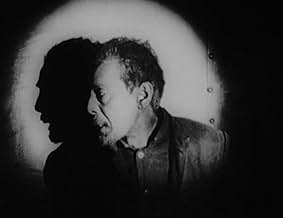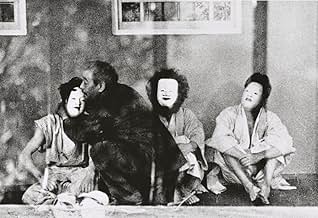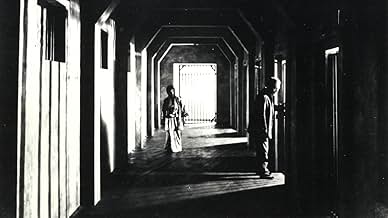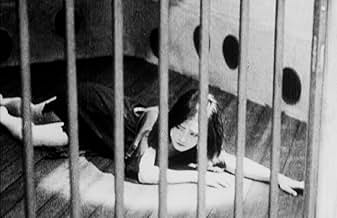VALUTAZIONE IMDb
7,3/10
4823
LA TUA VALUTAZIONE
Un uomo ottiene un lavoro in un manicomio nella speranza di vedere sua moglie.Un uomo ottiene un lavoro in un manicomio nella speranza di vedere sua moglie.Un uomo ottiene un lavoro in un manicomio nella speranza di vedere sua moglie.
Trama
Lo sapevi?
- QuizThis film was deemed lost for more than forty years, but it was rediscovered by its director, Teinosuke Kinugasa, in a rice cans in 1971.
- Versioni alternativeReissued in Japan in 1973 with musical score replacing original benshi.
- ConnessioniFeatured in Storia del cinema: Un'odissea: The Golden Age of World Cinema (2011)
Recensione in evidenza
Very few Japanese films exist from the silent period. In fact, statistics show that only 1% of around 7,000 productions are represented in the a catalogue of the silent cycle. Director Teinosuke Kinugasa's Kurutta Ippeji (also known as A Page of Madness) was thought lost (and perhaps forgotten) until he himself discovered a print in a warehouse in 1971. He diligently produced a new music soundtrack and re-released it. This is the first example of a silent film from Japan, and have to say that the world should be thankful that Kinugasa discovered this avant- garde little master work.
The film was produced with an avant garde group of artists, known as Shinkankak-ha (School of New Perceptions), an experimental art movement that rejected naturalism, or realism, and was highly influenced by European art movements such as Expressionism, Dada, and Cubism, and evidently uses the techniques found in Soviet Montage, particularly Sergei Eisenstein - fundamentally, as this project deals with madness, it would be easy to draw parallels with Robert Weine's seminal horror film Das Cabinet des Dr. Caligari (1920). What the art trope bring to this extreme nightmare are those exaggerated, pointed and alarmist movements like the expressionist acting styles being used in European film and stage work - but happens to find its own stylistic flourishes, and colloquial "voice" (for want of a better word).
Kurutta ippeji's simplistic story focuses on a man (Masuo Inoue) whom has taken a job as a janitor in an asylum, so that he may be close to his wife (Yoshie Nakagawa), who has been condemned. His aim is to aid in her escape from the dogmatic institution. However, when the break-out is orchestrated, her madness has enveloped her, and she is unwilling to leave with her husband. The couples daughter (Ayako Iijima) visits the asylum to advise her mother of her engagement, which leads to a maelstrom of fantastically abstract flashbacks, giving light to the reasons the mother is condemned.
The films style is so incredibly complex and technically brilliant. In the opening sequence, the jarring compositions (both beautiful and haunting), superimposition's, and quick montage editing, creates an assault on the senses that is difficult to break away from - torrential rain falls the scenery in shots of the asylum, expressionist compositions of wind-battered tree branches clashing with windows, and the sight of a woman riddled in madness. The use of superimposition becomes greater as the film moves into crescendo, and these layers portray climatically the merger of madness and modernity. Do we witness the ghosts that haunt the corridors of the asylum? Or are these the devastating spectre's of modernity, and the destruction of tradition? An ironic speculation perhaps, considering the mechanics of cinema production and exhibition.
To a modern audience, silent cinema is often a difficult watch. This film is of particular note for this argument. Kurutta ippeji has no title cards describing dialogue, or internal action, which makes it difficult to follow at times. But as with all 1920's Japanese cinema, the films were always accompanied by narration - a storyteller known colloquially as a benshi. But this small infraction does not hamper an incredibly dazzling piece of early experimental cinema, and one that should be viewed by any film enthusiast, at least for posterity - if not for a formative education on the stylistic diversity of film as art.
www.the-wrath-of-blog.blogspot.com
The film was produced with an avant garde group of artists, known as Shinkankak-ha (School of New Perceptions), an experimental art movement that rejected naturalism, or realism, and was highly influenced by European art movements such as Expressionism, Dada, and Cubism, and evidently uses the techniques found in Soviet Montage, particularly Sergei Eisenstein - fundamentally, as this project deals with madness, it would be easy to draw parallels with Robert Weine's seminal horror film Das Cabinet des Dr. Caligari (1920). What the art trope bring to this extreme nightmare are those exaggerated, pointed and alarmist movements like the expressionist acting styles being used in European film and stage work - but happens to find its own stylistic flourishes, and colloquial "voice" (for want of a better word).
Kurutta ippeji's simplistic story focuses on a man (Masuo Inoue) whom has taken a job as a janitor in an asylum, so that he may be close to his wife (Yoshie Nakagawa), who has been condemned. His aim is to aid in her escape from the dogmatic institution. However, when the break-out is orchestrated, her madness has enveloped her, and she is unwilling to leave with her husband. The couples daughter (Ayako Iijima) visits the asylum to advise her mother of her engagement, which leads to a maelstrom of fantastically abstract flashbacks, giving light to the reasons the mother is condemned.
The films style is so incredibly complex and technically brilliant. In the opening sequence, the jarring compositions (both beautiful and haunting), superimposition's, and quick montage editing, creates an assault on the senses that is difficult to break away from - torrential rain falls the scenery in shots of the asylum, expressionist compositions of wind-battered tree branches clashing with windows, and the sight of a woman riddled in madness. The use of superimposition becomes greater as the film moves into crescendo, and these layers portray climatically the merger of madness and modernity. Do we witness the ghosts that haunt the corridors of the asylum? Or are these the devastating spectre's of modernity, and the destruction of tradition? An ironic speculation perhaps, considering the mechanics of cinema production and exhibition.
To a modern audience, silent cinema is often a difficult watch. This film is of particular note for this argument. Kurutta ippeji has no title cards describing dialogue, or internal action, which makes it difficult to follow at times. But as with all 1920's Japanese cinema, the films were always accompanied by narration - a storyteller known colloquially as a benshi. But this small infraction does not hamper an incredibly dazzling piece of early experimental cinema, and one that should be viewed by any film enthusiast, at least for posterity - if not for a formative education on the stylistic diversity of film as art.
www.the-wrath-of-blog.blogspot.com
- tomgillespie2002
- 24 set 2012
- Permalink
I più visti
Accedi per valutare e creare un elenco di titoli salvati per ottenere consigli personalizzati
- How long is A Page of Madness?Powered by Alexa
Dettagli
- Data di uscita
- Paese di origine
- Lingue
- Celebre anche come
- Una pagina folle
- Luoghi delle riprese
- Kyoto, Giappone(Studio)
- Aziende produttrici
- Vedi altri crediti dell’azienda su IMDbPro
Botteghino
- Budget
- 20.000 JPY (previsto)
- Tempo di esecuzione1 ora 10 minuti
- Colore
- Mix di suoni
- Proporzioni
- 1.33 : 1
Contribuisci a questa pagina
Suggerisci una modifica o aggiungi i contenuti mancanti




















